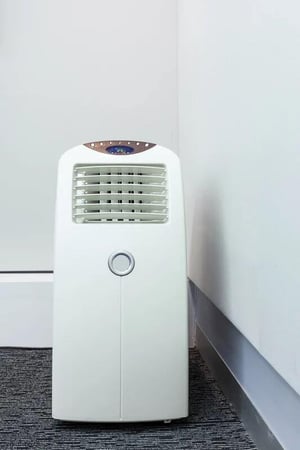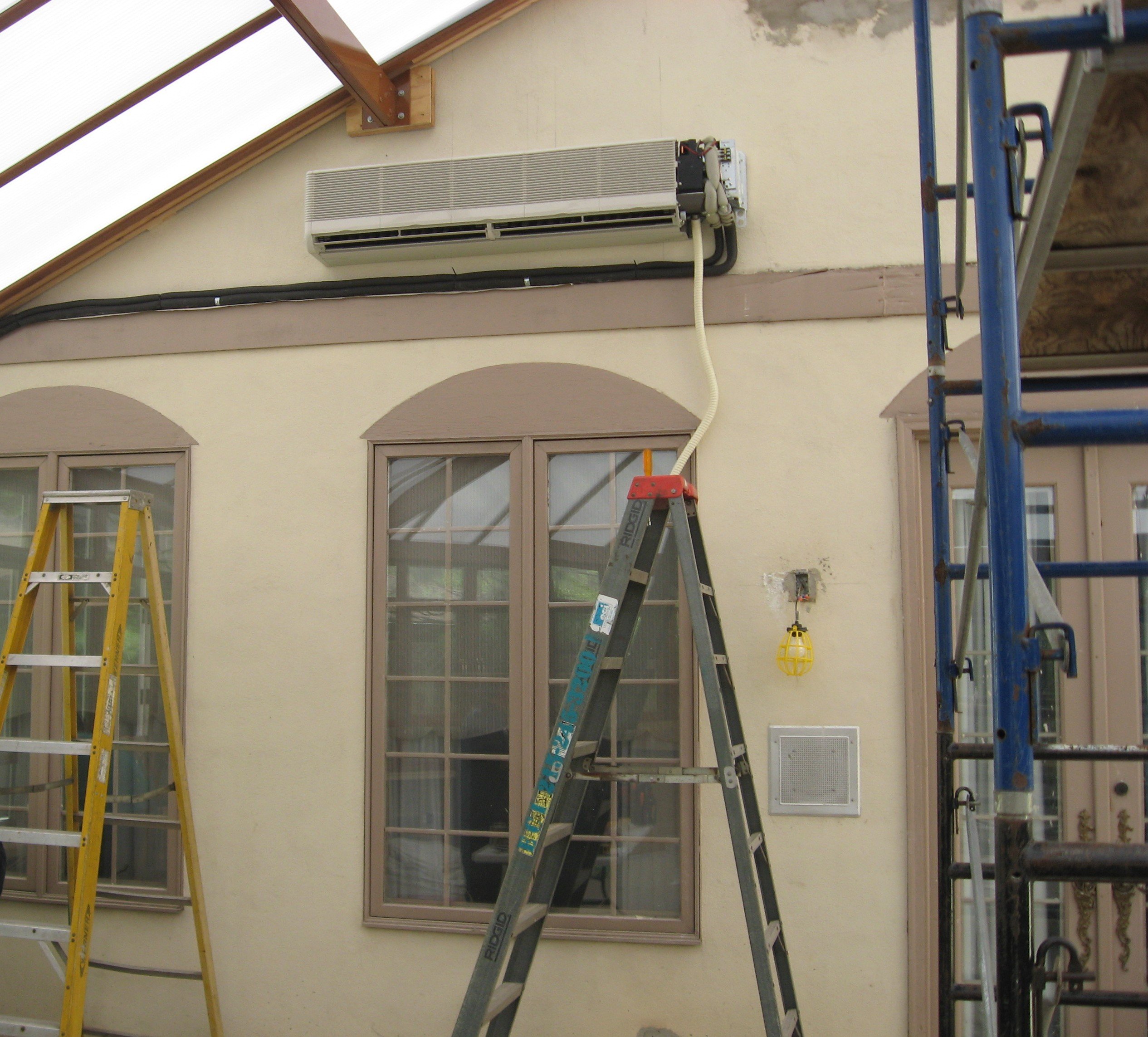Ductless Heating and Cooling in an All-Seasons Room in Philadelphia, PA
 Our homeowners in Philadelphia, PA, were excited about their new all-seasons room. It wasn’t some rinky-dink enclosed patio. No, this Chestnut Hill house was getting a major addition with a high, vaulted ceiling and big, beautiful glass panes all around.
Our homeowners in Philadelphia, PA, were excited about their new all-seasons room. It wasn’t some rinky-dink enclosed patio. No, this Chestnut Hill house was getting a major addition with a high, vaulted ceiling and big, beautiful glass panes all around.
The last piece of their puzzle, however, was keeping it warm in the winter and cool in the summer. After all, it’d be a shame to only really enjoy the new room when the weather was just right.
Our homeowners wanted reliable heating and cooling. But, they didn’t want to end up with massive increases in their monthly energy bills.
After all, there was a lot of new space to treat.  The high ceilings meant heat would rise and get trapped up there. And, all that glass would make the room very hot in the summer with the sun shining in.
The high ceilings meant heat would rise and get trapped up there. And, all that glass would make the room very hot in the summer with the sun shining in.
Our homeowners batted around a few ideas. But, none of them really fit the bill. Finally, they called us here at ECI. We took a look and talked through a few options.
Soon, they found the solution that was just right for their home.
Problem: A new all-seasons room needed heating and cooling. The homeowners wanted an effective and energy-efficient system.
Solution: Installed a Mitsubishi ductless mini split with two air handlers mounted to the home’s exterior wall and two heat pumps hidden behind a retaining wall.
Heating and Cooling an All-Seasons Room in Philadelphia
Portable Systems
 The first idea was space heaters and portable air conditioners. This method would have cost the least upfront. These sorts of appliances are very inexpensive.
The first idea was space heaters and portable air conditioners. This method would have cost the least upfront. These sorts of appliances are very inexpensive. But, in this case, you get what you pay for.
The thing about space heaters and portable AC’s is that they don’t have anywhere near the strength of a central system.
They’re also inconvenient: You have to lug them around. And you can’t leave a space heater on if you’re not in the room for a while. It’s a fire hazard.
And let’s be honest: These appliances would look ugly in this beautiful new room.
Sure, our homeowners could splurge on a fancy space heater that looked like a fireplace. But there’s no getting around a portable AC.
Finally, they’d see significant bumps on their bills. Even though these units don’t always do a great job, they use a lot of electricity.
Extending Ductwork
Their next idea was to extend their central heating and cooling system to reach the new room. That would mean building extra ductwork and adding a vent and return.
This way, they’d get the strength of their furnace and air conditioner — well, sort of. We’ll get into that in a moment.
The big hurdle here was new ducts. It would cost a lot of money to design, fabricate, and add the ductwork. Then, they’d have to build soffits around the ducts.
Those enclosures would take up space inside and change the look and feel of their home.
The other problem is the strength of their central system. The appliances they had were powerful enough for the home they had. Adding an extra room — let alone a large one with high ceilings — could put too much strain on it.
At the least, the whole house wouldn’t be comfortable. There wouldn’t be enough strength or air pressure to go around.
Worst case scenario? The furnace breaks down from being overworked. For a moment there, our homeowners were a little worried. Did they put the cart before the horse, planning out this great new addition and not having the perfect way to keep it comfortable?
Fortunately, the “just-right” solution was closer than they thought.
Ductless Heating and Cooling in an All-Seasons Room
.jpg?width=600&height=600&name=Ductless_Contest_System%20(1).jpg) An addition like this all-seasons room was a great candidate for a ductless heating and cooling system. And, as our homeowners explained the challenges they had, they also found themselves figuring out exactly wanted they wanted.
An addition like this all-seasons room was a great candidate for a ductless heating and cooling system. And, as our homeowners explained the challenges they had, they also found themselves figuring out exactly wanted they wanted.
Essentially, the portability of a space heater or small AC, with the strength of something that could treat an entire house.
And, one that didn’t use too much energy.
They’d begun to worry they were too particular. Could there be a system that would meet all those precise requirements?
There was: A mini split.
Installing a Ductless Mini Split
 What made the mini split a great solution was that we could permanently install the system without changing the look and feel of their home.
What made the mini split a great solution was that we could permanently install the system without changing the look and feel of their home.
It would be strong enough so that their new room felt as comfortable as the rest of the house. And, it would barely make an impact on their electric bill.
This system works because all you need inside are wall-mounted air handlers. They're responsible for circulating the air inside.
And, as the name implies, it doesn’t require ductwork. Just a small lineset that runs along the wall to a heat pump outside. It’s barely noticeable.
For this house we went with a unique setup: Two air handlers and two heat pumps.
Normally, one heat pump powers multiple indoor units. But this large sunroom was an exception. So, we designed a system that would provide the comfort they wanted without overloading anything.
Concealing the heat pumps
And, as we planned it, our homeowners pointed out a retaining wall near the house. They asked if the heat pumps could go behind it, even though it wasn't right next to the room.
Not only could we do that: We also ran the lines underground so no one would see or trip over them. Now the outdoor units are out of sight, too. 

Even in the winter, when it’s cold out, there’s enough heat to do the job. The heat pump amplified what little warmth there is until there’s enough to warm the room.
Then, in the summer, the system works opposite: It draws heat from the room and sends it outside. At the same time, it dehumidifies the air.
And these systems are powerful enough for an entire home. If our homeowners wanted to, they could install a few more air handlers inside and get rid of their old system.
But they just needed the one handler for their new room, and they’d enjoy a few other benefits.
Whisper-Quiet Operation
In this case, our homeowners chose to mount the handler high on the wall, close to the ceiling. These systems have state-of-the-art sensors and fans. No matter where you put them, they’ll treat the entire room.And they’ll do it virtually silently.
Even at full blast, these produce less than 25 decibels of sound. In other words, they’re no louder than leaves rustling outside. And, when they’re that high up on the wall, you’ll never be close enough to hear a thing.
Saving Money With a Ductless Mini Split
Now, for the big factor: The cost. Upfront, there’s a significant investment. After that, however, it’s almost free.We mentioned that heat transfer process before. It makes a big difference from combustion-based heating. You only need a small amount of electricity to run the pump.
Meanwhile, the air handlers do an amazing job circulating the air. That means you get the comfort you want faster.
After that, the handler switches to a low-power mode. This way, it uses even less electricity. And it maintained the temperature you want instead of clicking back on a few times an hour to correct any temperature fluctuations.

Our homeowners were happy they called us when they did. This way, they had plenty of time to run through all their options. And they decided on their system while the contractors were still building the room.
This way, it was all ready at once: Their beautiful new all-seasons room was all set for any temperature, any time of year.
Comfortable heating and cooling are often the final, and sometimes trickiest, part of a home addition. But it doesn’t have to be a hassle. Contact ECI for a free consultation, and we’ll help you find the solution that’s perfect for your home.






